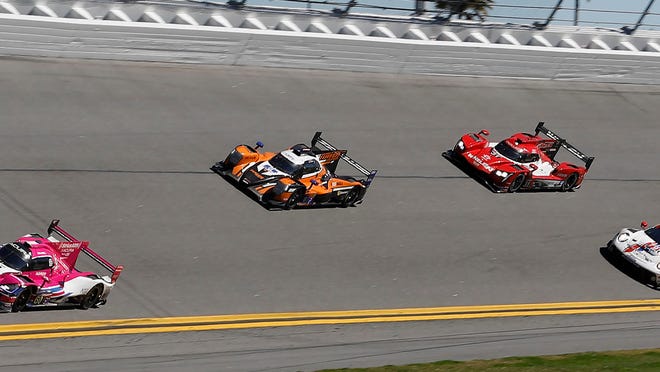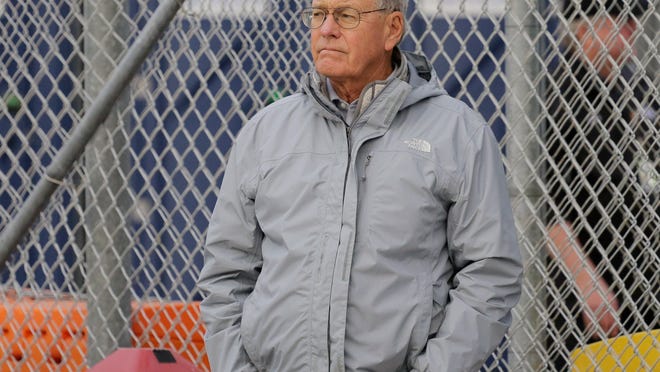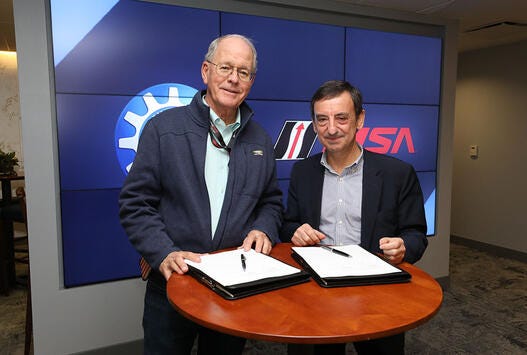
Like the duck’s feet, Jim France once got a lot done out of sight.
Depending on the day, he was either the “motorcycle France” or the “sports-car France,” or simply the family member, we were always told, whose under-the-radar work brought a lot of insight and oft-needed pragmatism to the boardroom.
In staying off-stage and unassociated — at least publicly — from things deemed controversial or even maddening to some, Jim was also known as “the France with no enemies.”
While he’s managed to maintain his good-neighbor status, his semi-clandestine work was found by the spotlight nearly four years ago when, under awkward circumstances, he stepped into the role of chairman and CEO of NASCAR, the organization founded by his father, Bill Sr., and run by Big Bill and then Bill Jr. from 1948 until the early-2000s.

Soon after Jim stepped up in August, 2018, he promoted Steve Phelps to president of NASCAR, a move allowing Jim to regather some oxygen for his road-racing endeavors, specifically IMSA, NASCAR’s sports-car arm.
(By the way, he also oversees American Flat Track, the dirt-track motorcycle series with a national schedule. He was a flat-track racer for several years in his youth.)
His sports-car efforts accelerated greatly with the 2014 merger of two major series — France’s Grand-Am (think Rolex 24) and Don Panoz’s American Le Mans Series — and the rebranded IMSA (International Motor Sports Association).
That launched a new era of sports-car racing in America, but also began a period of international diplomacy and trade talks of the four-wheeled, highly horsepowered variety — the goal was a set of rules and packaging that would allow Europe’s and America’s best teams to compete in each others’ events on each others’ famous tracks.
FIRST INDY:They’re right, you gotta see the Indy 500 to fully appreciate it | KEN WILLIS
NASCAR TO FRANCE?:NASCAR and Le Mans need to make the most of this opportunity | KEN WILLIS
That involved plenty of give-and-take from the marquee manufacturers as well as the engineers representing IMSA and their counterparts with the ACO (Automobile Club de l’Ouest).
They’ve done it, at least on paper, and it’s no small breakthrough, assuming you know anything about motorsports turf wars and the need for a competitive edge. It’s set to begin with the 2023 Rolex 24.
And that’s why, in advance of all that, Jim France will be in France this coming week to receive the Spirit of Le Mans Award the day before Saturday’s start of that historic 24-hour race.
Officially, he was obviously gracious and appreciative.
“I am deeply humbled and honored to be selected by close friend (ACO President) Pierre Fillon and the ACO Board of Directors to receive the prestigious Spirit of Le Mans Trophy this year. Joining the list of so many respected previous recipients is something that I and my family will forever cherish.”

Unofficially, this past week during a long sit-down in the big “GlassCar” building on Speedway Boulevard, he returned to the nuts and bolts and pragmatism of it all.
“The thing we have going with IMSA and Le Mans and the ACO, we’re trying to get our rules matched up. It’s been a big project,” he said.
But, again, they’re done, right? Well . . .
“Yes, but the key thing is, will the cars be able to compete together,” he asked rhetorically. “The engineers, if they’ve all done their balancing of performance, trying to get two cars with different rules packages matched up . . . the proof will be in the pudding. When the green flag drops, the BS stops, as they say.”
Porsche (with Roger Penske) and Cadillac (with Chip Ganassi) are preparing to field new prototypes and teams next year in IMSA as well as Europe’s World Endurance Championship, a six-race series headlined by Le Mans. If you’re looking to get out of the gate with momentum, it never hurts to hitch your wagon to Roger and/or Chip.
“From the fan standpoint, it gives us more manufacturer and factory-supported race teams, and well-funded private teams, competing together,” France said. “It gives us an opportunity right now to have Porsche back racing for the overall wins against Cadillac, against Acura, against BMW, against Lamborghini . . . all for the overall win. The technology and economics model was doable for them.”
The marketing lure for, say, Porsche and Cadillac is obvious. They sell cars in Europe and North America.
It seems obvious for both continents’ sports-car promoters, also. If Europe is open to Penske, Ganassi and others, those teams presumably bring along American attention. And vice versa for the top European teams when they tee it up at the Rolex 24, Watkins Glen, Sebring, etc.
Right about here, a little reminder seems appropriate. Sports-cars on road courses has been on NASCAR’s radar ever since Big Bill cranked the tractors to begin building his dream speedway in the late-’50s. He promoted a pair of races in 1957-58 at the New Smyrna Airport, and soon added an infield road course to Daytona International Speedway after its 1959 opening.
The coming-out party came in 1962 with the Daytona Continental, a three-hour race won by hot-rod god Dan Gurney, and within four years it became the 24-hour season-opening marathon we now know as the Rolex 24.
In the early days, the international rules were similar enough for some cross-pollination.
“Then their rules started differing from our rules,” France said. “Their approach, recently, was almost a Formula One level of sports-car racing — the cost of it. They came back quite a bit. That gave us the opportunity to get our formula and their formula on the track together.”
Jim France first went to Le Mans as a teenager, tagging along with his dad as they watched stock-car hero Fireball Roberts compete (quite well, by the way) in a Ferrari GTO. Fireball was an instant favorite of the French, and who knows, maybe that’s where the seed was firmly planted in Jim France’s head.
Fourteen years later, NASCAR’s Junie Donlavey and Hershel McGriff went to Le Mans but with their hulking stock cars. They couldn’t compete favorably with the purpose-built road-racing machines, but down the straightaways they were big and loud and fast and the road-side crowds were delighted. Veteran racer Dick Brooks was one of the drivers who went over.
“I talked to Dick quite a bit when he got back,” France said. “He said he had a fantastic time.”
Another seed? Maybe, but this one took 40-plus years to produce another opportunity, which comes next year when Hendrick Motorsports will take one of NASCAR’s Next Gen cars to Le Mans to compete in its own one-car category — the “Garage 56” entry, it’s called.
“What got me going on this was when we started doing our new car,” France said of the Next Gen, which debuted this season. “Le Mans and Pierre Fillon had come up with this Garage 56, more of a demonstration thing. I approached Pierre when we started the new-car project.
“Maybe we’d have the opportunity to revisit what my dad had done, bring the new car over there.”
What will spring from all this when the blending and blurring comes next year? Who knows, maybe nothing, maybe a lot. The world shrinks daily, you know.
Jim France’s first duties in racing, back when the Speedway opened in ’59, was stubbing tickets and working the parking lot. At 77, you’d think, the chairman and CEO roles at NASCAR would be a proper stopping point.
But it’s his coinciding role of IMSA chairman, it seems, that’s keeping the juices flowing and the jet fueled. Next stop: Val de Loire.
— Reach Ken Willis at ken.willis@news-jrnl.com
This news is republished from another source. You can check the original article here


